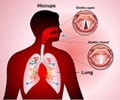Thanks to the gluttony and the consequent food habits prevailing in the US sixty per cent of Americans are hit by acid reflux, and the figure is rising.
Thanks to the gluttony and the consequent food habits prevailing in the US sixty per cent of Americans are hit by acid reflux, and the figure is rising. Experts are calling for appropriate changes in the diet.
Actually the 60 per cent figure relates to those who suffer episodic bouts only occasionally, but 25 per cent deal with the problem on a weekly basis.The prevalence of the condition in North America is increasing by about 5% a year, according to a 2007 study in the journal Clinical Gastroenterology and Hepatology.
A report in January from the Agency for Healthcare Research and Quality found that more than 95,000 people in the U.S. were hospitalized with acid reflux as a primary diagnosis in 2005, up 4.5% from 1998. But the number of people hospitalized with reflux as either a primary or secondary diagnosis reached 3 million in 2005 - an increase of 216% from 1998.
Gastroesophageal reflux disease, GERD or acid reflux, occurs when the small ring of muscle at the bottom of the esophagus weakens and allows stomach acid and food to back up, or reflux, into the esophagus after a meal. Common symptoms include heartburn, difficulty swallowing, an acidic taste in the mouth and nausea or vomiting.
The increase in obesity is speculated to be one cause of its growing prevalence. Excess fat in the abdominal area pushes on the stomach's contents; stomach fat causes distention and relaxes the lower esophagus; and fat-laden foods slow down the stomach's emptying process. Other factors include Americans' notoriously poor nutritional habits and a heightened awareness of the condition induced by pharmaceutical advertising.
Medications also may be contributing to the problem, Los Angeles Times reports.
Advertisement
Although medication is not a cure for acid reflux, a majority of patients find relief through prescription and over-the-counter drugs. Aside from traditional antacids, including Alka-Seltzer and Tums, there are now two main medications used to treat reflux.
Advertisement
A second medication is the proton pump inhibitor, which shuts down proton pumps in the stomach that produce acid. These are stronger than H2 blockers and recommended for people with more persistent, acute symptoms. Products such as Prilosec, Prevacid and Nexium are available only by prescription; Prilosec OTC is the only proton pump inhibitor available over the counter.
Even though there are a number of brands, Sharma said they all work similarly. He recommends patients use them for periodic acid reflux problems - once a week or twice a month.
There are some side effects associated with the medications, though most physicians say they are rare. Dr. Nicholas Shaheen, an associate professor of medicine and epidemiology and director of the Center for Esophageal Diseases and Swallowing at the University of North Carolina School of Medicine, said acid-suppressive medications are among the safest drugs he prescribes.
One potential issue is that stomach acid helps fight infection, so reducing acid could make individuals more prone to infections like pneumonia, said Dr. Stuart Spechler, chief of gastroenterology at the Dallas Veterans Affairs Medical Center and professor of medicine at the University of Texas Southwestern Medical Center at Dallas.
The medications also may block the absorption of vitamins and minerals such as B-12 and calcium, which could lead to hip fractures.
For people who have responded to medication but continue to experience symptoms such as heartburn or regurgitation, surgery is an option. Only about 5% of reflux patients undergo the minimally invasive procedure in which the upper part of the stomach is wrapped around the lower esophagus to re-create the weakened valve.
Some doctors are skeptics of the surgery, Spechler included. He said the procedure tends to "break down" over time, and though many of his surgical patients tell him their symptoms are improved afterward, few are completely cured.
In the late 1980s, Spechler and his colleagues performed a study comparing the results of patients on medication and those receiving surgery. A follow-up study in 2001 found that almost two-thirds of the surgical patients were back on medication.
Dr. David Rattner, professor of surgery at Harvard Medical School and chief of gastroenterology and general surgery at Massachusetts General Hospital, said the surgery is relatively simple; most people go home after 24 hours and are "100%" after about two weeks. Side effects of surgery are rare. They include difficulty swallowing, excessive gas or return of symptoms, particularly among obese patients. Spechler said deaths occur in about one in every 1,000 operations.
One final way to treat reflux is through various endoscopic procedures, including stitching or using radio-frequency waves to restore the lower esophageal muscles. Studies have shown that these procedures can reduce medication usage, are relatively safe and can improve quality of life.
But they are not time-tested and not commonly used. In 2002, the American Gastroenterological Assn. said endoscopic treatment is not a recommended therapy for reflux sufferers.
And so the simplest and safest option could be healthy food habits. But the current economic crisis could make millions of Americans fall back on the relatively inexpensive but nutritionally counterproductive fast food more and more. Acid reflux then could be there to stay, unless sustained efforts are made, it is feared.
Source-Medindia
LIN/M











